7 Jun 2013
Dynamic Warmup for Gymnasts
Lauren Downes MSPT
In the past ten years, much advancement has been made in the world of strength and conditioning, including the development of dynamic warmup routines. Gone are the days of stretching statically before a sporting event. Before soccer and lacrosse games, you will witness players doing a series of active exercises in straight lines, repeating the same exercise 10-20 times while in constant motion. They will progress to faster drills in the same patterns on the field. There is no reason why you shouldn’t see gymnasts completing the same routine, and do to the flexibility demands of the sport, dynamic warmup is even more important for these athletes to do.
There are several phases of warming up a muscle. First is the muscle activation phase, in which a gymnast performs a few repetitions of an exercise that will initiate contraction of a muscle. This phase is not meant for strengthening, hence the low repetitions. These exercises are examples of a muscle activation exercise:
SingleLegBridge: This exercise will activate your gluts and hamstrings. Lie on your back with one knee bent and the other leg hugged into your chest. Lift your buttocks about 5-6 inches off of the ground as you maintain a flat back with tight abdominals. Repeat 5-6 times on each side.
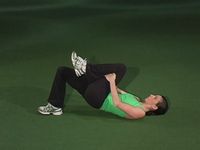
Deep Squat: Stand with your feet a bit wider than shoulder width apart, with your arms overhead. Squat down by sitting your buttocks back. The back should remain flat as the shoulders come forward. Place hands on the ground, then reach one to the sky and rotate toward that hand. Reach with the opposite hand. Repeat sequence 3-4 times
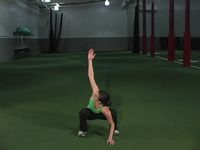
The next phase is the muscle mobility phase, which starts to introduce a dynamic stretch to a muscle, and will begin to increase the muscle tissue temperature. This is example of a muscle mobility exercise:
Dynamic Supine Hamstring Stretch: Lie on your back with your arms at your sides and your legs straight. Keeping a flat back and tight abdominals, raise one leg straight in the air, then lower it at a moderate speed. If it is more comfortable, bend the opposite knee. Only raise your leg to a comfortable level and do not let your back arch off of the ground. Repeat 5-6 times on each side. You may also raise the leg, then bring it slightly out to the side about 10-12 inches and back inwards 5-6 times. Do not allow the torso to rotate or the hip to lift off of the ground. Skip this last step if you have any hip problems.
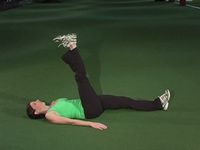 
The next phase of a dynamic warmup is the traveling mobility phase. In this phase, a gymnast utilizes an area of about 15 yards, adding consistent movement to the exercises. The temperature of the muscles rise, and each muscle is warmed up through its entire range of motion. Here are some examples of traveling mobility exercises:
Quadricep Stretches: Stand tall and bend your knee to bring your heel towards you buttocks, keeping the legs parallel to each other. Grab your foot with the hand on the same side, hold for about 3 seconds, then lower the leg. Step forward about 2 feet and repeat with the other side. Feel a stretch in front of your thigh. Continue the 15 yard distance. When you return in the opposite direction, you may stretch the front of your hip by leaning forward and reaching the opposite hand forward. Hold for about 3 seconds. Continue the 15 yard distance.
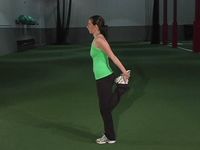 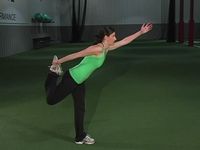
Inchworm: This is a hamstring stretch for the back of your thigh. Bend over to reach your hands to the floor, then walk your hands forward as far as you can. Maintain a flat back. Next, walk your feet forward with straight knees as close to your hands as you can. Don’t worry if you cannot bring your feet all the way to your hands. It will improve with practice. Repeat for the 15 yard distance twice.
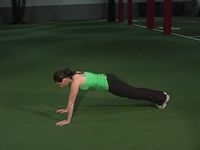 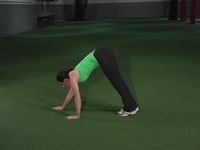
The final phase of a dynamic warmup is dynamic mobility, in which a gymnast uses the same 15 yard space to complete fast movement exercises such as high knee runs, lateral runs, and side skips, which will fully elevate the body temperature to the level it needs to be to perform on the ice.
There are many exercises that you may include in your dynamic warmup, and these are just a few examples from each phase from GymnasticStrong’s “Dynamic Warmup and Flexibility Training” DVD. After practicing an entire warmup, you can pick and choose which exercises target your ‘tight areas’ the best, and create a 10-20 minute warmup that is specific to your needs. You will be more prepared for your practice session or competition, and less prone to injury. *CLICK HERE to view this DVD. *Click **
|